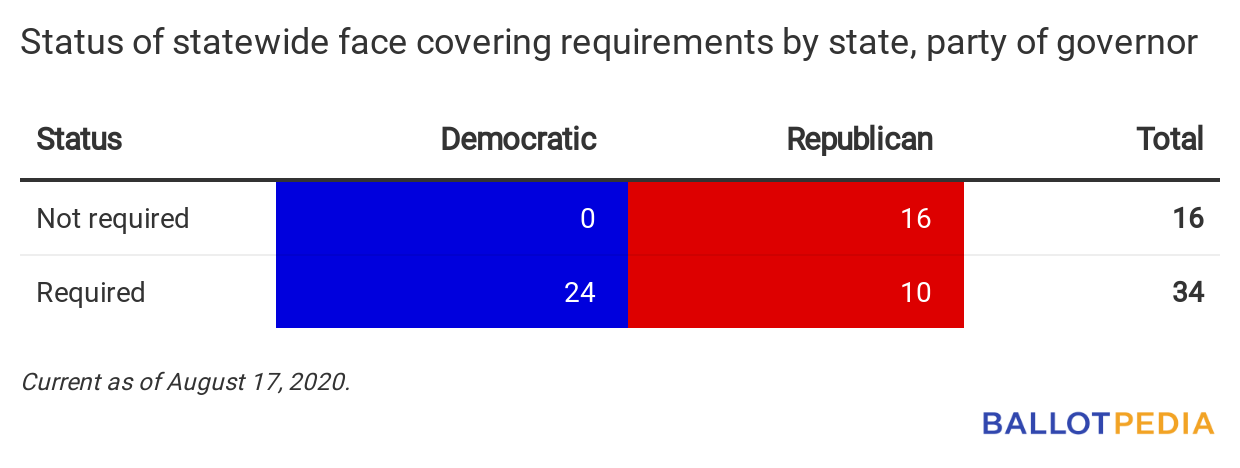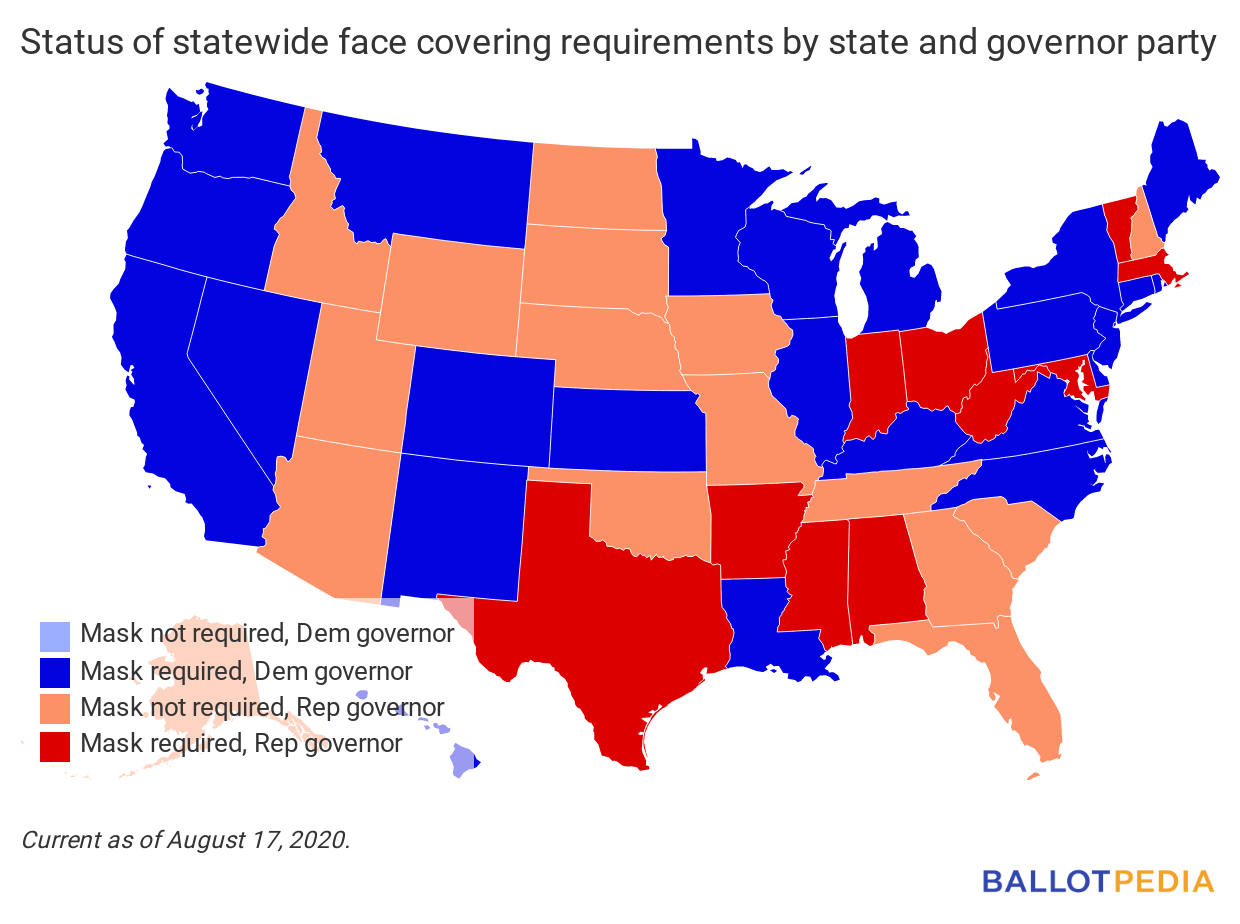Each day, we:
Want to know what happened Friday? Click here. The next 24 hoursWhat is changing in the next 24 hours?
Since our last editionWhat is open in each state? For a continually updated article on reopening status in all 50 states, click here. For our last edition, click here.
Tracking industries: Face coveringsAll 50 states are reopening in some way. Here, we give the status of one industry or activity across the states. Today’s question: in which states must you wear a face covering in public? We last looked at face coverings in the Aug. 10th edition of the newsletter. Since then, no new states have adopted a mask mandate or let a mask mandate expire. On Aug. 15, Georgia Gov. Brian Kemp (R) signed an executive order allowing local governments to enact mask mandates. |
|||||||||||||||||||||||||||||||||||||||||||||||||||||||||||||||||||||||||||||||||||||||||||||||||||
 
This is an in-depth summary of two state plans to reopen public K-12 schools for the 2020-2021 school year. Minnesota’s Safe Learning Plan for 2020-21On July 30, Gov. Tim Walz (D) announced the state’s guidelines for school reopening, the Safe Learning Plan for 2020-21. Walz stated, “As a classroom teacher for more than 20 years and a parent of a child in public schools, I am committed to providing a world-class education to our students while keeping them and their teachers safe. With this approach, we are pairing the knowledge and data from our Departments of Health and Education with the expertise of our local school districts to make the best decisions for our students across the state.” Minnesota does not have a statewide date for public schools to reopen—individual districts that meet the state’s requirements can set their own timelines, depending on the virus’ effect on their community. According to EdWeek, public schools in Minnesota traditionally start the academic year after Labor Day, with the exact start date varying by district. On March 15, Walz announced the closing of all K-12 schools in the state from March 18 to March 27. On March 25, Walz extended the closures until May 1. Walz closed schools for the remainder of the academic year on April 23. ContextMinnesota has a divided government. The governor is a Democrat, and Democrats have a majority in the state House while Republicans have a majority in the state Senate. The state has had a divided government since 2015. The following tables show public education statistics in Minnesota, including a rank comparing it to the other 49 states. Rank one is the highest number of each figure, rank 50 is the lowest. All data comes from the Common Core of Data provided by the National Center for Education Statistics.
DetailsDistrict reopening plans Districts are responsible for developing their own reopening plans in coordination with local health departments. The guidance does not say whether the plans must be posted publicly. In-person, hybrid, and online learning Local school districts determine the specific model for learning. That decision must be based on health data and made in coordination with state guidelines. School districts are given the base model for the type of instruction from the state based on the county’s health data for the previous two weeks. The guidance document specifies which model is required based on the data:
Schools are then required to consult with local public health officials and choose a model for the start of the year. Individual districts can decline or limit in-person instruction at their own discretion, even if the state’s guidelines permit it. After the year begins, schools are to monitor the local health data to determine if a change in learning model is required. All students also have the option to attend virtually. According to the Minnesota Department of Education, “Regardless of which learning model is being implemented at the school building, all school districts and charter schools must offer an equitable distance learning model to all families who choose not to attend in-person learning due to medical risks or other safety concerns.” Mask requirements All faculty, staff, and students are required to wear face coverings, with exceptions for children under the age of five and those with documented disabilities that make wearing a face covering unreasonable. The state will provide one cloth mask for every teacher, staff member, and student in public schools. In-person health recommendations and requirements When learning is done in person, all schools are required to have a preparedness plan that addresses health and safety practices. The state’s guidance document does not provide specific requirements, but it does say each school’s preparedness plan should address the following:
The state’s planning guide encourages the use of playground equipment if six feet of physical distancing is possible. The state also requires markers on the floor in high traffic areas to encourage distancing and requires that schools discontinue self-service of food in cafeterias. If a student or staff member tests positive for COVID-19 or comes in close contact with someone who has tested positive, they must quarantine for 14 days. School districts are required to develop a testing and response strategy with local public health officials to determine the best practices for responding to positive cases and symptomatic students. Transportation and busing requirements and restrictions The plan requires all students and staff to wear face coverings while on school transportation. If a school is operating under a hybrid model with social distancing requirements, buses are limited to 50% capacity, according to the state’s planning guide for schools. ResponsesAfter the plan was unveiled, Deb Henton, executive director of the Minnesota Association of School Administrators, said, “I do believe that our educators in the state are going to be happy with the decision. Some school districts are going to have to be in the full-on distance learning mode that they may not have wanted to be in, but they understand.” Wisconsin’s Education ForwardThe Wisconsin Department of Public Instruction released Education Forward, its guidance document for school reopening, on June 22. State Superintendent Carolyn Stanford Taylor said, “The next school year will be likely be [sic] different from the learning environment students and teachers have grown accustomed to. Education Forward is meant to provide information for educators and school officials as they make decisions regarding their school operations to keep all students and staff safe while learning.” On July 7, Gov.Tony Evers (D) said the state’s plan allows local districts to make reopening decisions they feel are right for their communities. He told The Capital Times, “It’s important for school districts and parents and kids to be prepared but at the end of the day, I would not consider a district who offers a hybrid where it’s partially in school, partially online to be failing in their responsibilities. They have to make that decision locally.” Wisconsin does not have a statewide date for public schools to reopen—individual districts that meet the state’s requirements can set their own timelines. According to EdWeek, public schools in Wisconsin typically start the academic year on September 1 or later, with the exact start date varying by district. On March 13, Evers closed all K-12 schools across the state from March 18 through April 5. He extended the closure indefinitely on March 17 before closing them for the remainder of the year on April 16. ContextWisconsin has a divided government. The governor is a Democrat, and Republicans have majorities in both chambers of the state legislature. The state has had a divided government since 2019. The following tables show public education statistics in Wisconsin, including a rank comparing it to the other 49 states. Rank one is the highest number of each figure, rank 50 is the lowest. All data comes from the Common Core of Data provided by the National Center for Education Statistics.
DetailsDistrict reopening plans The Education Forward guidance document is not binding on local districts, which are responsible for developing their own specific reopening plans. In-person, hybrid, and online learning The guidance document outlines all-remote, physically distanced (hybrid), and full-time in-person learning options for localities to consider. School districts are allowed to determine and implement the best learning model for their community’s needs. In-person learning, according to the plan, is defined as a situation where “the vast majority of students attend in-person. Some students (those with health concerns) may participate virtually on an as-needed basis.” In the physically distanced learning model, “learning occurs both in-person and virtually, utilizing classrooms, outdoor learning spaces, homes, and community-based organizations.” The virtual learning option allows education to take place completely remotely “using digital, analog, synchronous, asynchronous, or hybrid instructional models.” Mask requirements The plan recommends teachers, staff, and students wear masks whenever feasible—face coverings are not required. In-person health recommendations and requirements For in-person learning, the guidance document recommends physical distancing of six feet or more. The document also recommends schools implement daily health screenings and temperature checks. To reduce traffic and keep students physically distanced, the guidelines recommend modifications to collective lunch times (staggering lunch times, choosing alternative spaces to eat, or implementing a lunch delivery to classrooms). The plan also recommends districts and schools stagger recess, arrival, and departure times. The document recommends schools adopt their own policies and procedures to comply with local social distancing ordinances. The document says schools are responsible for informing local public health officials when students or faculty test positive for or exhibit symptoms of the coronavirus. Transportation and busing requirements and restrictions The guidance document does not offer specific recommendations for transportation and busing. It does say districts should “collaborate with transportation vendors to implement a busing plan meeting social distancing requirements, if necessary. Include a plan for pick-up, in-transit, drop off, and cleaning and disinfection protocols.” ResponsesThe Wisconsin Education Association Council said local teachers should be involved in school and district decision-making. On Aug. 1, WEAC President Ron Martin said, “WEAC believes any plan for reopening schools must ensure the health and safety of our students and staff and also prioritize long-term strategies on student learning and educational equity. We must have the time and resources to reopen safely… but that requires funding. WEAC restates our stance that all decisions must be guided by science. We want nothing more than to be back at school with our students, but we can only be there safely when the Badger Bounce Back benchmarks are met.” Additional activityIn this section, we feature examples of other federal, state, and local government activity, as well as influencers relevant to recovering from the pandemic.
|
|||||||||||||||||||||||||||||||||||||||||||||||||||||||||||||||||||||||||||||||||||||||||||||||||||
Documenting America’s Path to Recovery: August 17, 2020
By

